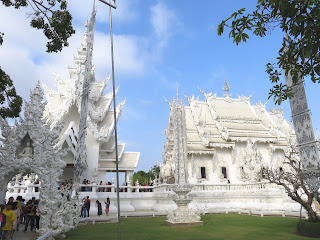We have a 400-year-old castle in the center of town. Well, to be fair it's really the ruins of a castle. Even so, it's an impressive sight and many of our festivals and fairs are held in an area adjacent to the castle compound. It's completely surrounded by cherry trees, so it's a popular spot during the Cherry Blossom festival, and whenever the weather is good, for families and friends to picnic, for people to stroll. The castle and surrounds are also frequented by local artists.
The inside of the castle grounds has a large wooden structure which functions as a visitors center and museum, telling of the history and function of the original castle, which burned to the ground some time ago. It was, as were all such structures in Japan from this period, made entirely of wood.
Sasayama was not an important military outpost. The castle served as a way-station for the visiting samurai. But like all castles of its time, protection from hostile takeover was a basic requirement. Its first level of fortification consisted of moats, an outer moat and an inner moat. These obviously wouldn't be very effective against cruise missiles or Predator drones but they served the purpose at the time, erecting a formidable obstacle at the time for any aggressors, who were usually on foot.
Now the moats perform an entirely different function. Both inner and outer moats are the home of ducks and turtles. The turtles were a bit elusive this year. I couldn't get any shots of them sunbathing, meditating, doing what turtles have been doing long before the castle was built -- say going back at least four million years. Turtles are behaviorally a quite stable species, to put it mildly.
The moats definitely offer the many visitors who visit this historic site, something more interesting to experience and enjoy than the stone wall fortification -- the second line of defense -- which forms the base the entire perimeter of the castle grounds.
One of the outer moats also has a very special function. In spring and summer, the city rents row boats. No jet skis, no submarines, no hover craft. Only row boats. That pretty much fits the pace here.
This year the experience of the picnickers, revelers, stroller, artists, and ducks and turtles, was dramatically heightened. A local high school connecting their students with nature and community service had them plant lotus flowers. The effect was breathtaking.
[ This originally appeared at the author's personal website . . . https://jdrachel.com ]
Living In Japan: Lotus Flowers, a Castle, and a Moat









